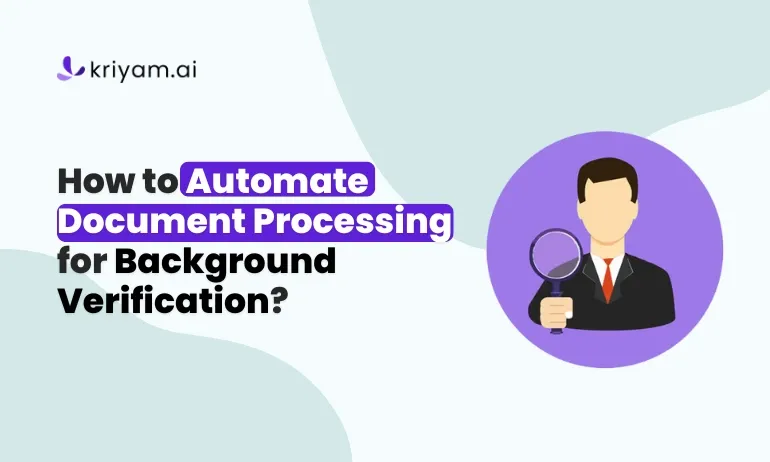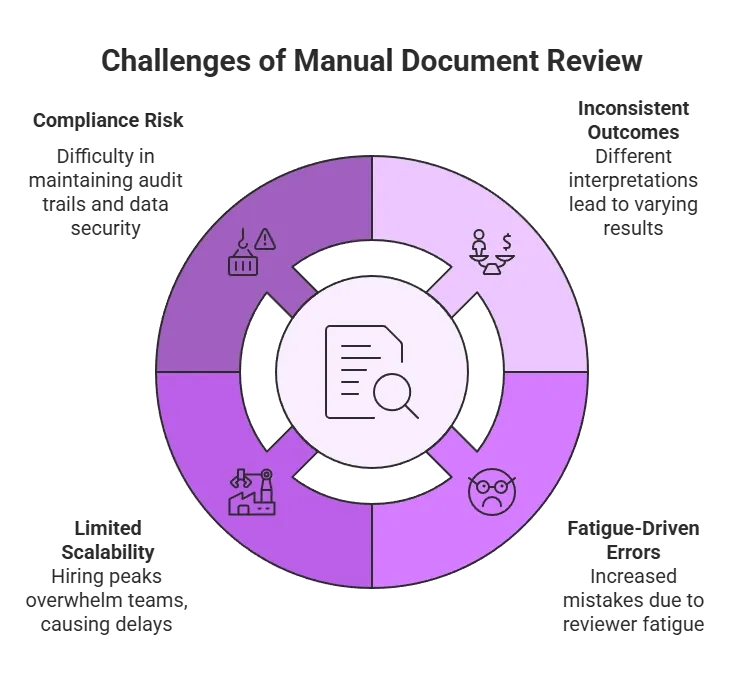How to Automate Document Processing for Background Verification?
Sharlyn Bedi | 16th April, 2025
5 min reads
Sharlyn Bedi | 16th April, 2025 | 5 min reads

With remote work becoming the norm and employee onboarding happening at scale, background verification (BGV) teams are under immense pressure to deliver faster and more accurate results. The expectations have shifted; what used to take days is now expected in hours. Organizations are demanding quicker turnaround times (TAT), seamless onboarding journeys, and strict compliance. However, many of the BGV workflows still incorporate manual document review, physical verification, and spreadsheets to coordinate a system for document review. This is not feasible. These processes are slow, error-prone, and not aligned with compliance and speed required in today's digital hiring instructions.
Whether it's verifying address proof, identity documents, education records, or previous employment credentials, the growing volume and variety of documents are stretching manual verification teams thin. Without automation, these teams struggle to keep up with rising workloads while maintaining quality and compliance.
The Hidden Problem: Manual Document Processing Slowing You Down
Behind every delayed background check is often an overworked verification team stuck handling repetitive, manual document processing tasks. Sorting scanned IDs, cross-verifying employment letters, checking for forgery or mismatch, these tasks not only slow down the process but also introduce inconsistencies and risks.

Manual document review brings with it a host of operational challenges:
Inconsistent outcomes: Different reviewers may interpret the same document differently, leading to varying results.
Fatigue-driven errors: As volumes scale, fatigue sets in, increasing the likelihood of mistakes or missed red flags.
Limited scalability: Hiring peaks can easily overwhelm teams, causing backlogs and delays in onboarding.
Compliance risk: Manually managing document workflows makes it difficult to maintain a clear audit trail or enforce data security protocols.
In short, the traditional approach to document processing is not just slow, it’s risky and unsustainable at scale. And yet, most teams don’t realize that the real bottleneck isn’t verification itself, but the way document intake, sorting, and validation are being handled.
Need for Document Processing in Background Verification
At the core of every background verification process lies one critical function: Document processing. Whether it's confirming a candidate’s identity or validating their past education or address, every step depends on the accurate extraction, review, and verification of submitted documents. Some of the key document types involved include:
Government-issued IDs (e.g., Aadhaar, Passport, Driver’s License)
Address proofs (utility bills, rental agreements)
Academic records (mark sheets, degree certificates)
Employment-related documents (experience letters, salary slips)
The efficiency and accuracy of processing these documents directly determine the reliability of the overall background check. If a single ID is misread or if an educational certificate is missed during manual review, it can result in incomplete or flawed verification reports, causing compliance issues, delays, and even reputational risks for the organization.
In short, document processing isn’t just a part of the BGV workflow, it’s the foundation. And inefficiencies here lead to a domino effect across the entire verification cycle, from longer TATs to compromised decision-making.
What’s Broken in Today’s Background Verification Workflows?
Despite digital transformation in HR and onboarding, many background verification workflows are still trapped in outdated, manual models. Here's where the cracks begin to show:
- Manual reviews are error-prone: Human checks, especially under time pressure, often lead to data entry mistakes, document mismatches, and missed red flags.
- Slow turnaround times: Sifting through stacks of PDFs or scanned documents consumes valuable time, leading to delays in onboarding and poor candidate experience.
- Scaling is nearly impossible: As hiring volumes grow, verification teams often hit a wall, unable to process more documents without proportionally increasing headcount.
- Compliance becomes fragile: Fatigue and oversight increase the risk of non-compliance, especially with evolving privacy laws and audit requirements.
The current system is reactive, not proactive. Instead of enabling verification teams to focus on risk assessment and decision-making, they’re bogged down by the burden of repetitive, manual processing tasks.
It’s clear what’s broken isn’t just speed or accuracy. It’s the very model of how background verification is being done today.
Intelligent Document Processing (IDP): A Game-Changer for Background Verification
Modern background verification demands speed, precision, and scalability, qualities that traditional document handling methods simply can’t deliver. That’s where Intelligent Document Processing (IDP) becomes a transformative solution.
IDP uses a blend of AI technologies to handle documents intelligently, from ingestion to validation, without requiring constant manual intervention. Here’s how it fits seamlessly into the background verification workflow:
What Powers IDP?
- OCR (Optical Character Recognition): Digitizes printed and handwritten content from scanned or uploaded documents.
- Natural Language Processing (NLP): Understands and contextualizes text to extract relevant information accurately.
- Machine Learning (ML): Learns from document patterns, improving accuracy across different formats and layouts.
- Robotic Process Automation (RPA): Automates repetitive tasks like sorting, labeling, routing, and exception handling.
Together, these components create a system that doesn’t just process documents, it understands and verifies them.
For background verification teams, this means:
- No more manual parsing of ID proofs or education records
- Immediate classification of documents and extraction of key data
- Real-time cross-checking with trusted sources for validation
- A secure, auditable trail built into every step
IDP brings consistency, scalability, and compliance to document processing, making it the new backbone of fast, reliable background checks.
Read Also: 5 Ways Agentic AI is Transforming Insurance Industry
How IDP Transforms Background Document Processing: A Step-by-Step View
Here’s what modern document automation looks like with IDP embedded into your background verification workflow:

Step 1: Upload or Ingest Multi-Format Documents
Documents are uploaded through portals, email, or HR systems. IDP supports varied formats, including PDFs, scans, images, or even photos taken from mobile devices.
Step 2: Automatic Document Identification
Without any manual tagging, IDP identifies the document type, whether it's an Aadhaar card, mark sheet, or address proof, using pattern recognition and layout understanding.
Step 3: AI-Powered Data Extraction
IDP extracts critical fields, like name, DOB, address, degree title, and issuing authority while ignoring irrelevant content.
Step 4: Real-Time Validation Against Trusted Sources
Extracted data is automatically verified against databases such as government APIs, internal systems, or third-party sources. This flags fake, expired, or mismatched entries instantly.
Step 5: Direct Integration into Your Verification Workflow
Clean, validated data flows into your BGV system, feeding reports, dashboards, or reviewer queues without delay or formatting effort.
Why Are Background Verifiers Shifting to IDP?
- Faster Turnaround: Reduce document processing time by up to 80%, enabling quicker onboarding decisions.
- Fewer Manual Errors: Automation cuts out fatigue-based mistakes and improves consistency across large volumes.
- Built-in Compliance: With clear audit trails, secure handling, and consistent validation, IDP makes it easier to meet data protection and audit requirements.
Choosing the Right BGV Solution with Intelligent Document Processing
If you're looking to modernize your background verification operations, choosing the right IDP-enabled platform can make all the difference. Kriyam’s Intelligent Document Processing solution is purpose-built for verification teams who need speed, accuracy, and compliance without added complexity.
Why Kriyam for Background Verification?
- Plug-and-Play IDP Platform: Designed for verification ops, Kriyam’s platform is ready to deploy with minimal setup or technical overhead.
- Pre-Trained Models for Document Types: From government-issued IDs to academic credentials and financial documents, Kriyam’s models are already trained for real-world use cases, minimizing setup time.
- Seamless Integrations: Easily connect with ATS, HRMS, or your existing background verification tools, no data silos, no switching screens.
- Real-Time Document Validation & Fraud Detection: Instantly detect mismatches, forged documents, or missing data, before it enters your reports.
- Compliance-Grade Security & Audit Readiness: Built with enterprise-grade security controls, complete data traceability, and audit logs so you're always compliance-ready.

Final Thoughts
Manual document handling is no longer fit for the pace and scale of today’s hiring and compliance needs. With Intelligent Document Processing, verification teams can unlock faster turnaround times, improved accuracy, and fully auditable workflows, all while reducing operational load. The future of background verification is automated, intelligent, and secure with Kriyam AI. Schedule a demo to know more!
Got Questions? We have Answers
1. What is Intelligent Document Processing (IDP) in background verification?
IDP uses AI technologies like OCR, NLP, and ML to automatically extract, classify, and validate data from documents. It removes the need for manual document handling during background checks.
2. How does IDP improve accuracy in background verification?
IDP reduces human errors by standardizing document processing, identifying inconsistencies, and validating data in real time against trusted sources.
3. Can IDP be integrated with my existing BGV tools or HR systems?
Yes. Platforms like Kriyam offer ready integrations with ATS, HRMS, and BGV tools, allowing seamless data exchange and workflow automation.
4. What types of documents can be processed using IDP?
IDP can handle identity proofs (Aadhaar, PAN, Passport), education records, address verifications, financial statements, and more across multiple formats.
5. Is IDP compliant with data protection regulations?
Absolutely. Kriyam’s IDP platform includes data encryption, access controls, and detailed audit trails to ensure compliance with DPDP Act and other industry standards.
About the author
Sharlyn Bedi
Junior Content Strategist
Sharlyn Bedi | Junior Content Strategist
A passionate writer with a knack for automation and process optimisation. Through clear, actionable insights, her content is best for leaders to stay updated on latest trends on technology and automation.
Interests: Business Automation, Process Optimization, Digital Transformation
Content Overview
Share
FEATURED
Automation
Top 5 Best Field Service Management Software in 2025
Best Field Service Management Software
Shreyas R
27th November, 2023



